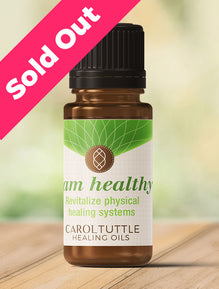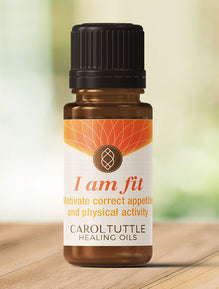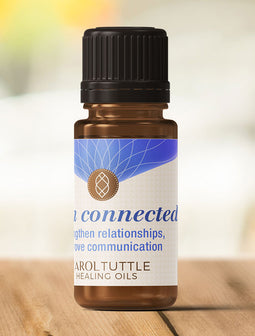I am nurtured
Restore positive emotions and self-acceptance
$68.00 Regular
Oil Blend Benefits:
Supports deep emotional healing and self-acceptance. Emotional restoration. Restores a sense of who you truly are and how you truly feel and think.
Chakra Activation: Creation, Heart
Size: 10ml (0.33 fl. oz.)
Main scent notes:
Citrus, Light Floral, Sweet
Out of stock
Save 20% when you buy
the complete collection

How to use
These essential oil blends ease your healing in simple, effective ways. You’ll get the most benefit if you apply them correctly and regularly.
The 5 simplest, most effective ways to use Carol Tuttle Healing Oils:
• Direct Inhalation
• Bath
• Topical
• Diffusing
• Massage
For clear, in-depth instructions for each method, visit our “How to Use” page.
The 5 simplest, most effective ways to use Carol Tuttle Healing Oils:
• Direct Inhalation
• Bath
• Topical
• Diffusing
• Massage
For clear, in-depth instructions for each method, visit our “How to Use” page.
Ingredients
Ingredients:
100% pure premium grade organic or wildcrafted essential oils of Cinnamon Bark, Balsam Fir, Lavender, Frankincense, Spearmint, Lime, Helichrysum, Thyme ct. Linalool, Patchouli
Cinnamon Bark Cinnamon Bark oil is one of the most universal oils because of its wide range of uses. This oil is one of the few oils indicated for circulation and heart stimulation. Other treatment uses: the flu in general, digestive issues, blood sugar issues, impotence, and tropical fevers, and a wide range of infections. When highly diluted, it has been used effectively as an anti-parasitic oil against scabies. Inhaling the aroma can be invigorating, especially when mentally or emotionally fatigued, tired and weak.
Balsam Fir has properties that promote the healing of injuries of various kinds, both physical and emotional. Helps with respiratory issues, various joint pain and muscle aches. As with most evergreen oils, it also has a general ability to be uplifting to the mood.
Lavender is a first choice for skin care due to its quick healing abilities and powerful-yet-gentle action. It is effective for use on burns and sunburns. It works to prevent swelling and scarring from burns. It is among the most widely used essential oils for emotional support. It is the “aspirin” of essential oils.
Frankincense is highly desired. This oil strengthens the respiratory system, rejuvenates the skin, and is anti-humoral. It has the unique ability to pass the blood-brain barrier, aiding both physically and emotionally. It is hugely beneficial for strengthening the immune system. Aids in balancing emotions in times of depression, anxiety, grief, stress, and trauma.
Spearmint is a popular oil in food products. While spearmint and peppermint are often used for similar purposes, it is far gentler, cooling, and sweeter than peppermint, and is a favorite among children. It helps to lower blood pressure, nausea, diarrhea, muscle cramps, and headaches. It keeps away moths, ants, flies, and mosquitoes.
Lime oil has many antioxidants which lend to its many anti-aging properties. A little goes a long way. It has a very strong aroma and flavor when used in recipes. Its antidepressant properties leave one feeling refreshed and lighter which may help with fear or anxiety. Use in a toner for oily, acne prone skin. Phototoxic—avoid direct exposure to the sun or tanning booths for 12 hours after use on skin.
Helichrysum aids in nerve regeneration and circulation. Recent studies show a possible link to heart attack prevention. Can reduce the effect of insect bites, and the development and appearance of scars or stretch marks. Shown to be effective in treating emotional issues such as stress and mental fatigue.
Thyme ct. Linalool has strong antibacterial, antifungal, and antiviral properties. Very effective against colds, flu, and other respiratory issues that have lingered on. Stimulating for the circulatory system. Pain relieving to aches and pains of the muscles and joints. A strong germ fighter, it may strengthen the immune system. This chemotype of Thyme is very hot, as such, it should be used with caution, safe in a blend. Helps in relieving stress by helping us to think clearly under duress.
Patchouli has a varied range of uses. A favorite choice as an antidepressant and aphrodisiac, it is also used for fungal infections, skin issues, weight control, some types of acne, and tissue regeneration. Patchouli is effective against poisonous plants, relief from bee stings and insect bites, and as an anti-parasite treatment against certain classes of parasites.
100% pure premium grade organic or wildcrafted essential oils of Cinnamon Bark, Balsam Fir, Lavender, Frankincense, Spearmint, Lime, Helichrysum, Thyme ct. Linalool, Patchouli
Cinnamon Bark Cinnamon Bark oil is one of the most universal oils because of its wide range of uses. This oil is one of the few oils indicated for circulation and heart stimulation. Other treatment uses: the flu in general, digestive issues, blood sugar issues, impotence, and tropical fevers, and a wide range of infections. When highly diluted, it has been used effectively as an anti-parasitic oil against scabies. Inhaling the aroma can be invigorating, especially when mentally or emotionally fatigued, tired and weak.
Balsam Fir has properties that promote the healing of injuries of various kinds, both physical and emotional. Helps with respiratory issues, various joint pain and muscle aches. As with most evergreen oils, it also has a general ability to be uplifting to the mood.
Lavender is a first choice for skin care due to its quick healing abilities and powerful-yet-gentle action. It is effective for use on burns and sunburns. It works to prevent swelling and scarring from burns. It is among the most widely used essential oils for emotional support. It is the “aspirin” of essential oils.
Frankincense is highly desired. This oil strengthens the respiratory system, rejuvenates the skin, and is anti-humoral. It has the unique ability to pass the blood-brain barrier, aiding both physically and emotionally. It is hugely beneficial for strengthening the immune system. Aids in balancing emotions in times of depression, anxiety, grief, stress, and trauma.
Spearmint is a popular oil in food products. While spearmint and peppermint are often used for similar purposes, it is far gentler, cooling, and sweeter than peppermint, and is a favorite among children. It helps to lower blood pressure, nausea, diarrhea, muscle cramps, and headaches. It keeps away moths, ants, flies, and mosquitoes.
Lime oil has many antioxidants which lend to its many anti-aging properties. A little goes a long way. It has a very strong aroma and flavor when used in recipes. Its antidepressant properties leave one feeling refreshed and lighter which may help with fear or anxiety. Use in a toner for oily, acne prone skin. Phototoxic—avoid direct exposure to the sun or tanning booths for 12 hours after use on skin.
Helichrysum aids in nerve regeneration and circulation. Recent studies show a possible link to heart attack prevention. Can reduce the effect of insect bites, and the development and appearance of scars or stretch marks. Shown to be effective in treating emotional issues such as stress and mental fatigue.
Thyme ct. Linalool has strong antibacterial, antifungal, and antiviral properties. Very effective against colds, flu, and other respiratory issues that have lingered on. Stimulating for the circulatory system. Pain relieving to aches and pains of the muscles and joints. A strong germ fighter, it may strengthen the immune system. This chemotype of Thyme is very hot, as such, it should be used with caution, safe in a blend. Helps in relieving stress by helping us to think clearly under duress.
Patchouli has a varied range of uses. A favorite choice as an antidepressant and aphrodisiac, it is also used for fungal infections, skin issues, weight control, some types of acne, and tissue regeneration. Patchouli is effective against poisonous plants, relief from bee stings and insect bites, and as an anti-parasite treatment against certain classes of parasites.
Safety Notes
Safety Notes: Keep out of reach of children and avoid contact with eyes. Phototoxic- Avoid direct exposure to sun for 12 hours after use on skin.
If applying an essential oil to skin, always perform a small patch test by properly diluting the oil in an appropriate carrier oil and applying to an insensitive part of the body, such as inside of elbow. Never put oils in the ear canal or eyes. Use vegetable or milk to remove any essential oils causing irritation. Always keep essential oils and blends away from children. To slow oxidation and protect shelf life, store in a cool, dark place with lids tightly secured.
Disclaimer: This information is provided for educational purposes only, not to treat, cure, prevent, or diagnose any disease or condition, or prescribe in any way. As with all essential oils, do not take internally unless working with a qualified and expert practitioner. Always consult doctor before taking any oil.
If applying an essential oil to skin, always perform a small patch test by properly diluting the oil in an appropriate carrier oil and applying to an insensitive part of the body, such as inside of elbow. Never put oils in the ear canal or eyes. Use vegetable or milk to remove any essential oils causing irritation. Always keep essential oils and blends away from children. To slow oxidation and protect shelf life, store in a cool, dark place with lids tightly secured.
Disclaimer: This information is provided for educational purposes only, not to treat, cure, prevent, or diagnose any disease or condition, or prescribe in any way. As with all essential oils, do not take internally unless working with a qualified and expert practitioner. Always consult doctor before taking any oil.






